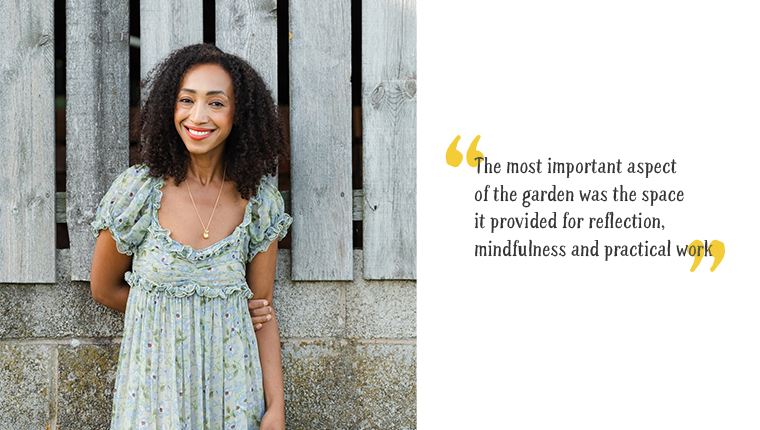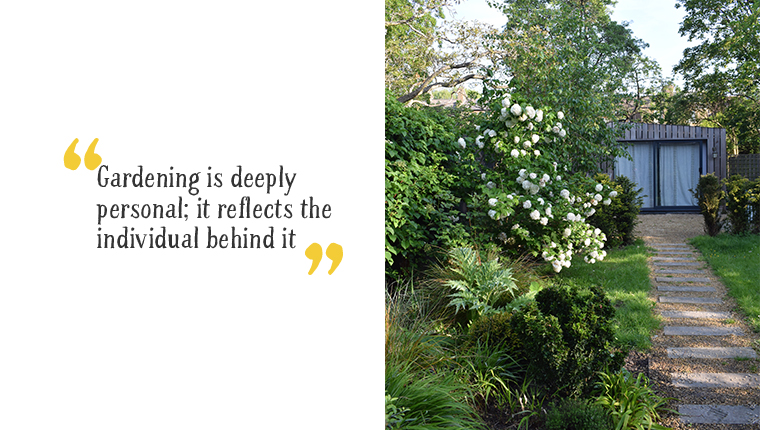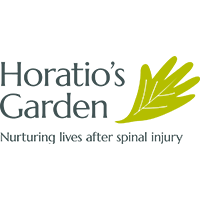The real gift of the garden is to simply enjoy it

Image ©Andrea Gilpin
Designer, writer and broadcaster Hazel Gardiner’s life has been shaped by the beauty of design, floristry and gardens, both as a visitor and a gardener. She shares her experiences of the power of gardens, including Maggie’s, not just to inspire, but also to aid recovering after a life-threatening illness.
I’ve visited many National Garden Scheme gardens over the years, and they’ve been a great source of inspiration and intrigue, says Hazel. I’ve explored gardens across the country, but I find the opportunity to visit residential gardens in my own borough particularly enriching. Seeing what thrives in the same soil and climate is invaluable – I’ve learnt that a garden in Southwark is entirely different from one in Hackney, London has many microclimates.
What makes the experience even more special is speaking with the owners. Gardening is deeply personal; it reflects the individual behind it. Walking into someone’s garden feels like stepping into the pages of their diary – so much can be learned about a person by seeing their green space. National Garden Scheme gardens truly embody the healing power of nature and connection, granting access to these private havens. I deeply appreciate them both personally, as someone who is visually inquisitive, and professionally, as someone always on the lookout for new plant and colour combinations as a horticulturist.
I’d always enjoyed gardens but my cancer experience completely shifted my perspective on life. It forced me to slow down and appreciate the small, often overlooked moments and introduce boundaries. I had to look inward and ask myself: if I was fortunate enough to survive, how did I truly want to live, how did I want to spend my time? This meant working on my mental wellbeing just as much as my physical recovery.
I also changed the way I viewed rest – not as a luxury, not as selfish, but as a necessity, as essential as eating or sleeping. Before my diagnosis, I often pushed myself to exhaustion, but I came to understand that true rest isn’t just about stopping; it’s about replenishing and resetting, about allowing space for renewal – just like in nature.

My cancer treatment also made me fully embrace gardening. My diagnosis coincided with buying my first flat, which had a small but promising outdoor space. During my recovery, tending to that space gave me a sense of purpose and structure and it’s where my passion began.
I was kind to myself in the learning process – I didn’t berate myself for not knowing plant names or for starting from scratch. Before cancer, I had been a perfectionist, held back by a fear of failure. Gardening helped change that narrative. I gave myself grace in the garden, and in turn, I gave myself grace in life. The simple joy of watching something grow that I had planted sharpened my self-belief and confidence when I needed it most.
The most important aspect of the garden was the space it provided for reflection, mindfulness and practical work. Whether I was tending to plants or simply sitting among them, the garden helped centre my thoughts and calm my mind. The rhythms of nature – growth, dormancy, renewal – mirrored my own healing process, reminding me of the beauty of resilience and how whatever happened a new day would present itself.
I also became acutely aware of the persistence of plants. During my recovery, I would visit gardens all around the UK and notice how many plants were determined survivors. The heather clinging to a windswept cliff in Cornwall, the buddleia thriving in a crack in a London pavement – they all embodied resilience. Touching the bark of a 200-year-old oak tree reminded me of my own place in the world – small in the grand scheme, yet strong. There is both humility and strength in witnessing nature’s endurance.
I was fortunate to have the support of Macmillan during my treatment. I was assigned a nurse the same week I was diagnosed, and their services were invaluable – not only in providing medical care but also in offering emotional support. Having a dedicated individual focused solely on my wellbeing was a completely new experience, but it became a crucial part of my recovery.
Although I was diagnosed in the noughties, years before retraining in floristry, I have always been deeply sensitive to my surroundings, with passions spanning interiors, architecture, art, and fashion. I did find the duality of receiving both medical treatment and emotional support in the same building conflicting at times. However, Maggie’s centres provided a calm and beautiful environment, both inside and out – something I now realise resonated with me on a profound level.

I sought support at Maggie’s West London, where the garden embraces and greets you first, ahead of entering the joyful orange building. Tree and plant flanked pathways lead you to the centre – it’s a beautifully designed transition. This journey offered me a moment of introspection and clarity before stepping inside. Being immersed in such a nurturing environment was mood shifting which eased the confronting conversations that often took place inside.
One of my most treasured moments was meeting Dan Pearson, who designed this garden for Maggie’s. I was filled with gratitude – his thoughtful, restorative design played a huge role in my emotional rehabilitation, offering transformation at a time when I needed it most.
For me, gardens, fresh air and sunlight are integral to wellbeing and should be accessible to all. As a cancer survivor, I know firsthand how deeply healing gardens can be – they offer rest, reflection, and rejuvenation. Simply sitting on a bench with the sun on my face, listening to birdsong, can lower stress and shift my mindset. Gardening also encourages movement, whether it’s light pruning or something more vigorous like digging.
Beyond the personal benefits, gardening is a community-led passion. Whether you’re growing alone, working in an allotment, or visiting a National Garden Scheme garden, you’re surrounded by kindred spirits, people united by a shared love of plants. It’s a beautifully inclusive, uplifting feeling. And, perhaps most importantly, gardening demands presence – it’s the ultimate act of mindfulness. That blissful state of losing track of time after heading out “just to deadhead some roses” is not only joyful but genuinely beneficial for mental health.
Hazel’s ‘feel good in the garden’ prescription:
An hour outside, divided into three restorative activities:
One hour of joyous, mindless activity – weeding, pruning, or shaping topiary. Tasks that don’t require over thinking but still bring satisfaction.
One hour of outdoor dining with friends – because for me, gardens are best enjoyed when they’re full of life and laughter.
Thirty minutes of doing absolutely nothing – but truly embracing it. Sitting in the garden at dusk, listening to birdsong, watching the sun set. Too often, we spend time in our gardens working, critiquing, or feeling frustrated about what hasn’t been achieved. The real gift is in simply enjoying it.
This story was originally published in the 2025 Little Yellow Book of Gardens and Health – to read it click here


















